Must Know High School Biology - Kellie Ploeger Cox 2019
PART FOUR Evolution
The Evidence for Evolution
MUST ![]() KNOW
KNOW
![]() Molecular similarities, anatomical evidence, and the fossil record all provide evidence for evolution.
Molecular similarities, anatomical evidence, and the fossil record all provide evidence for evolution.
The argument that evolution is only a “theory” doesn’t take into account the overwhelming sum of scientific findings that again and again bolster the concept of species changing over time.
Molecular Similarities
It’s safe to say that the more closely related two organisms are, the more similar their DNA and protein sequences. In fact, try ranking the following organisms from having the highest similarity with your own DNA to having the lowest number of nucleotide bases in common: chicken, chimp, fruit fly, another human, and yeast.
If you think about it logically, you can group these organisms based on similarities to yourself. Yeah, good chance that you and another person have a lot in common (genetically speaking). A chimp is a primate (as are you), so that’s another good bet. A chicken is a bird, not a mammal like us, but it is a vertebrate, unlike that fruit fly. And a yeast cell? Hm. Not a close relative. So, if you check out the table below, there shouldn’t be any huge surprises.
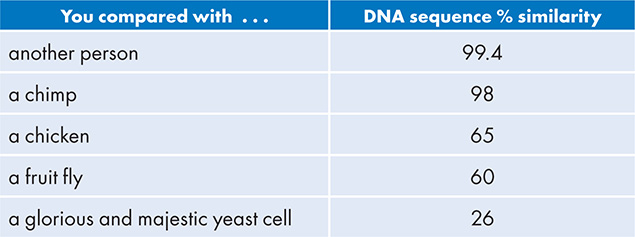
A comparison of the sequence of amino acids in a particular protein is another way to establish relatedness. When choosing a protein, it’s best to look at one that is found in all forms of life. If a protein is found in many different types of organism, it suggests it evolved early in Earth’s history and was so important to cell function that throughout evolutionary time, it was “conserved” for its original use. Its importance means the protein-encoding gene remains intact and relatively free of mutations. That isn’t to say there aren’t some changes in the sequence of nucleotides (and thus a change in the amino acids of the protein), but the changes are minimal. The protein cytochrome C is an excellent choice because it is found in all eukaryotic cells and plays a very important role in the electron transport chain. It is a chain of about 100 amino acids, and homologous similarities of cytochrome C are suggestive of common ancestry.
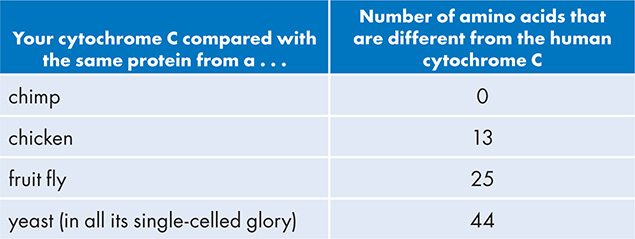
Notice that when comparing cytochrome C, the lower the number means a more similar protein because we’re counting the number of different amino acids.
Anatomical Evidence
If you look at two different species of snake, you can easily tell they’re related because they are both snake-shaped; their anatomies are similar. Yet anatomic evidence of common ancestry can be more subtle than comparing the overall body shapes of two different critters. This includes studying developmental similarities, homologous structures, and analogous structures.
Developmental Similarities
Usually, if critters resemble each other as embryos, they are closely related and have a common ancestor. Surprisingly, a human embryo looks a lot like a fish embryo, and sure enough, we share a vertebrate common ancestor. As the embryo develops, the initial similar body plan will begin to change and look more like the adult form. This happens because certain genes switch on and direct changes that lead to the formation of specific bits like tails, legs, wings, or gills. Regardless of the critter, all vertebrate embryos have three special structures: a tail, tiny limb buds, and pharyngeal arches. As I said earlier, as development continues, species-specific genes switch on and start to mold the embryo into its final body plan. That tail in a human embryo goes away as development continues, and the pharyngeal arches end up as part of our inner ear (as opposed to gills).
![]()
IRL
Yes, some people are born with “tails.” Please don’t make the mistake of thinking it’s this wonderful, wagging appendage that could act as a prehensile fifth hand. No, it’s simply a vestigial structure due to the embryonic tail vertebrae not being reabsorbed back into the embryo during normal embryonic development. Sorry to disappoint.
Homologous Structures
Homologous structures are body parts that are structurally similar in different species (because they share a common ancestor) but can have very different functions. For example, bat wings, human arms, dog legs, and dolphin flippers are all constructed of the same bones of the arm (humerus, radius, ulna) and hands (carpals, metacarpals, phalanges). This shouldn’t be a huge surprise considering we’re all mammals and are very closely related. The cool thing about homologous structures is how different they look, thanks to natural selection’s ability to carve a structure into a form most fit for the environment. A bat’s wing is obviously for flying, and a dolphin’s flipper is for swimming. Same bones, different functions! Now, there’s a chance that a homologous structure may not be used much in a certain species, and evolution will eventually cause it to wither into a small and useless form.
![]()
It’s common for structures not actively used in a species to become minimized and “go away.” Natural selection chooses adaptations that are useful; non-useful structures can be too much energy to keep and may eventually fade away.
Vestigial Structures
Vestigial structures are homologous structures that no longer perform a function. For example, mammals that eat a lot of plant material have a structure at the beginning of the large intestine called a cecum. It’s a large pouch that provides housing for mutualistic bacteria that help break down the difficult-to-digest cellulose found in plant cell walls. Our cecum has shrunk down to a small pouch, including the appendix, a little finger-like extension that doesn’t do much besides cause some excitement when it becomes inflamed in some unlucky individuals and needs to be immediately removed (an appendectomy).
![]()
IRL
New research suggests that the appendix may still serve an important function as a home for beneficial gut bacteria!
Analogous Structures
Analogous structures are interesting because they’re like the opposite of homologous structures: they look similar, but don’t have a common origin. Bird wings and insect wings look similar (they both look like … uh … wings) but have developed from totally different tissues: bones and feathers versus membranes. These two animals—birds and insects—are not close animal relatives, because one is a vertebrate and one is an invertebrate. But as a testament to the power of evolution, these two distant relatives both independently evolved to have wings because of the similar environment in which they live.
Geological and Fossil Evidence
Geological evidence of Earth’s age was a key component of Darwin’s understanding of evolution. During the early 19th century, the common belief was that our planet was formed only a few thousand years earlier, and since that time, neither Earth nor the life-forms on it have changed. The theory of evolution, however, not only states that life-forms have indeed changed, but the timescale necessary for this slow process to occur is possible because of the true age of Earth.
This crucial geological evidence was provided by the geologists Hutton and Lyell, both mentioned earlier in this unit. Hutton’s theory of gradualism stated that geological structures (layers of sediment, or great canyons) were formed through slow changes over long periods of time. Later, Lyell added to the theory by also discovering that those slow changes occur at a constant rate and are still occurring today. His theory was called uniformitarianism. This changed the understanding of Earth’s age (which is 4.6 billion years old!) and provided a timeline in which the slow process of natural selection could occur.
Fossils provide a picturesque physical record of evolutionary history. It documents the presence of organisms that are no longer on Earth and proves that life is, indeed, changing. Otherwise you’d be stopping your car to let the occasional giant sloth cross the street.
![]()
IRL
The giant ground sloth of over 2 million years ago grew 17 feet tall. That. Is. Awesome.
Even though we uncover the skeletons of critters that are no longer here, they often bare an uncanny resemblance to current life-forms. A Mesohippus fossil looks very much like modern-day horses and, sure enough, Mesohippus is the ancestor of your friendly neighborhood equine! It’s also cool to see the extinct species change as their fossils are uncovered in shallower and shallower sediment layers. Because of Hutton and Lyell’s theories, we understand that the slow geological processes formed the layers of Earth by depositing sediment. Newer sediment layers are higher up; the lower you dig, the older the timescale.
If you take a cross section of the fossils found in all these layers, it provides a really cool snapshot of how species change over time. Horses, in particular, provide an intriguing example. Their early ancestor Hyracotherium (50 million years ago) looked more like an antelope than a horse, and had toes instead of hooves! Because of natural selection, many toes became vestigial structures and the middle toe became bigger, eventually forming the modern-day horse hoof. A horse is actually walking on only its middle toes and the hoof itself is a huge, tough fingernail!
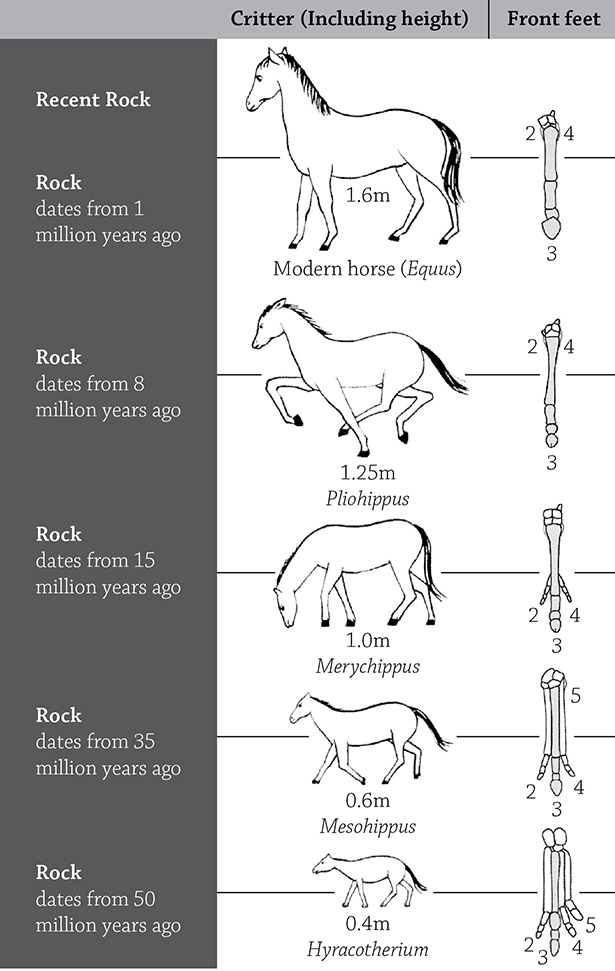
Fossil record of horse evolution
Author: Horseevolution. https://commons.wikimedia.org/wiki/File:Horseevolution-es.png
REVIEW QUESTIONS
1. Based on molecular similarities, rank the following organisms from most closely related to a human to the least closely related to a human:
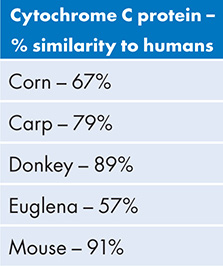
2. Developmental similarities exist in all vertebrate embryos, regardless of what their adult form looks like. What three structures are found in all vertebrate embryos?
3. Choose the appropriate term from the following pairs: A butterfly wing and a bird wing are examples of homologous/analogous structures because they do/do not arise from a common ancestor.
4. The leaves of a cactus have been modified into spines, and the Venus flytrap’s “mouth” is also a modified leaf. The spines and the “mouth” are examples of _________________ structures.
5. Choose the correct term from the following pair: The lower/higher the sediment layer, the older the fossilized species.
6. A previous question listed the percent similarities between different organisms and a human:
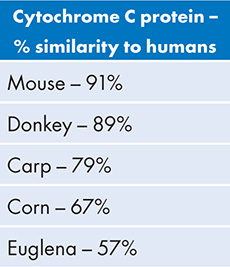
Explain why these results make sense. Don’t use quantities (e.g., percent similarity) in your answer. Instead, use logic to explain why the ranking seems “right.”
7. What is the relationship between homologous and vestigial structures?
8. What is the driving force behind the development of analogous body structures?
9. Fill in the blank and choose the correct term from the pair in bold: Hutton’s theory of _________________ stated that geological structures were formed through fast/slow changes over long periods of time.
